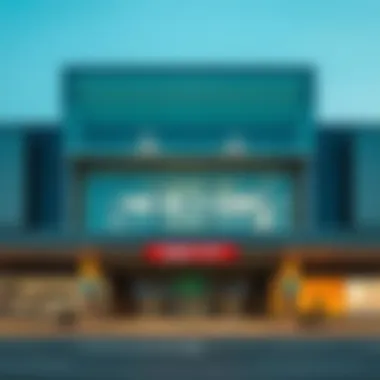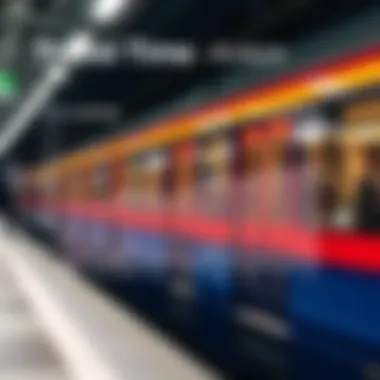Operational Hours of Dubai Metro: A Comprehensive Guide


Intro
Navigating a city like Dubai requires an understanding of its transportation infrastructure, especially the Dubai Metro, which has become a lifeline for both residents and visitors. Given its role in the urban transport ecosystem, comprehending the operational hours of the metro service is crucial, not just for daily commuters, but also for investors and property enthusiasts who wish to tap into the evolving real estate market around the metro stations.
The Dubai Metro operates on a schedule designed to accommodate a bustling population, ensuring that people can get from one part of the city to another with ease. This is especially important in a metropolis where time is often of the essence. People looking to invest in local real estate can't afford to overlook how the metro's hours align with their potential clients' lifestyles.
In the sections that follow, we'll delve into aspects such as current market trends, emerging suburbs, investment opportunities, and the key factors that influence property value within this vibrant city. The key points will provide not only an overview but also actionable insights tailored for investors, buyers, agents, and developers who aim to make informed decisions in this fast-paced environment.
Understanding these operational nuances isn’t just about convenience; it’s about positioning within the broader landscape of Dubai's ongoing growth. With that in mind, let's dive into the current trends shaping this dynamic market.
An Overview of Dubai Metro
The Dubai Metro stands as a landmark achievement in urban public transportation, bridging the dynamic cityscape with an efficient transit system. This rapid transit network is not just a means of commuting; it reflects Dubai's ambition, modernity, and dedication to smart city solutions. Understanding the operational hours of this essential service provides insights into how the metro facilitates daily mobility for both residents and visitors, fostering economic growth.
History and Expansion
The inception of the Dubai Metro dates back to the early 2000s, when the need for a reliable transportation alternative became apparent with the rapid population growth and increasing vehicle congestion. The construction began in 2006, and the first few lines were operational by 2010. Over the years, the network has expanded significantly, introducing new stations and extending lines to accommodate the ever-increasing demand.
- 2006: Construction begins.
- 2010: First lines operational.
- 2015 onwards: Ongoing expansions with new lines and stations being added.
This expansion has turned Dubai's Metro into one of the longest driverless metro systems globally, connecting key areas, commercial hotspots, and residential neighborhoods.
Current Metro Lines and Stations
As of now, the Dubai Metro comprises two main lines: the Red Line and the Green Line. Together, they encompass over fifty kilometers of track, covering numerous stations that serve diverse neighborhoods and attractions.
- Red Line: Spanning from Rashidiya to UAE Exchange, this line connects major business hubs and is crucial for commuters.
- Green Line: Running from Etisalat to Dubai Creek, it links several residential areas and commercial districts.
Additionally, the metro serves as an important connection point to other modes of public transport, such as buses and water taxis, ensuring seamless travel across the city.
Significance in Urban Transportation
The significance of the Dubai Metro extends beyond mere transport. It provides a sustainable solution to urban mobility, reducing the reliance on personal vehicles and alleviating traffic congestion. With the operational hours strategically scheduled to match peak usage times, it maximizes convenience for travelers.
Furthermore, the metro plays a pivotal role in enhancing the economic fabric of the city. By facilitating easy access to workplaces, shopping districts, and entertainment venues, it stimulates local businesses and attracts foreign investments.
"Dubai Metro's operational hours are designed to cater to its diverse user base, from early morning commuters to late-night adventurers."
In essence, understanding the operational hours of the Dubai Metro is crucial for making the most of its offerings, whether you're an investor looking into real estate near stations or a tourist seeking efficient travel across the city.
Metro Start Times Explained
Understanding the operational hours of the Dubai Metro is crucial for anyone navigating the bustling cityscape. Knowing when the trains run can significantly impact travel plans, whether it’s commuting to work, attending meetings, or simply exploring the city’s rich tapestry. The metro’s scheduling intricacies also have broader implications, influencing how both residents and visitors plan their day around the available transit options.
Key benefits of grasping these start times include:
- Optimization of Travel Plans: Knowing the exact start hours allows passengers to plan their journeys more efficiently. Missing a train can mean unnecessary delays.
- Avoidance of Congestion: Insights into peak and off-peak hours help in avoiding crowded trains, making for a more pleasant travel experience.
- Connection with Other Services: Comprehending metro schedules can facilitate smoother connections to buses, taxis, or even other tourist attractions, enhancing overall mobility.
Weekday Operational Hours


On weekdays, the Dubai Metro operates from early morning until midnight, with the service starting at 5:00 AM and concluding around 12:00 AM. This timetable is especially designed to accommodate the working population of Dubai, a melting pot of cultures and a hub for business activities.
During these hours, the frequency of trains varies:
- Morning Rush Hour: Trains run every 2-5 minutes between 7:00 AM and 9:00 AM. This is when the majority of commuters are using the system, and the service is ramped up accordingly.
- Midday Period: Later in the day, the frequency adjusts to around 5-10 minutes as the passenger load decreases.
- Evening Rush Hour: After work hours, the metro sees a spike in usage once more, and services are again increased, typically from 5:00 PM to 8:00 PM.
Understanding these patterns can significantly improve your commuting experience, ensuring smooth transitions between various points of interest.
Weekend and Holiday Schedules
Weekends in Dubai bring a slight shift in the metro’s operational framework, catering to leisure travelers and those enjoying the vibrant city life. On Fridays, the metro starts a bit later, at 10:00 AM, and runs until 1:00 AM the following day. Saturdays and Sundays, however, revert back to the standard weekday hours, beginning at 5:00 AM.
Key aspects to consider on weekends include:
- Late Night Services: The extended hours on Friday nights give revelers a chance to enjoy the nightlife without the worry of transportation.
- Less Frequent Service: During off-peak periods, expect longer waits compared to weekdays; trains may operate every 7-15 minutes.
- Holiday Variations: On public holidays, it's always prudent to check the official schedule since timings can be adjusted to accommodate increased travel demand.
Special Events and Service Adjustments
During significant events or festivals, the Dubai Metro may implement modified schedules to meet the surge in demand. Considerations for special events include:
- Extended Hours: For instance, during the Dubai Shopping Festival or National Day celebrations, trains might run later. This helps cater to the influx of tourists and locals participating in festivities.
- Increased Frequency: Similar to weekdays, special events often mean additional trains running at shorter intervals to alleviate crowding.
- Service Alerts: It is advisable to stay updated through the official RTA website or the Dubai Metro app, which provides timely alerts on any specific changes to the usual schedule.
Knowledge of the Dubai Metro's schedule gives travelers a strategic advantage. Whether avoiding rush hour or catching the last train home, being informed makes for a smoother journey.
Efficient navigation of the Dubai Metro hinges on understanding these operational intricacies. By taking the time to grasp the start times, commuters can establish a more resilient travel strategy, ensuring they remain connected to all that Dubai has to offer.
For more detailed information, you can visit Dubai RTA or refer to resources on Wikipedia.
Understanding Frequency and Timing
Understanding the operational frequency and timing of the Dubai Metro isn’t just about knowing when the train leaves. It’s a dance of logistics that enhances travel efficiency, customer satisfaction, and urban mobility. For investors, property buyers, and developers, grasping this aspect can shape business strategies and investment decisions significantly.
Interval Between Trains
The interval at which trains arrive is a crucial element of the metro’s schedule. Typically, during peak hours, trains run every 2 to 3 minutes. This sort of frequency is designed to handle the rush of commuters who rely on the metro to get to work or school. When the clock strikes 7 AM, you can expect the platforms to buzz with activity, akin to an ant colony during harvest time. Knowing these timeframes can aid commuters in planning their journeys better.
Conversely, off-peak times see intervals stretching to about 7 to 10 minutes. This does not mean riders are left stranded; even at longer intervals, the system remains highly efficient. It allows passengers to hop on the next train without much of a wait, meaning you can conveniently grab a coffee or check your messages without fearing you’ll miss your ride.
In essence, the interval between trains is not just about speed; it is about a strategic flow that accommodates varying passenger volumes through the day. This notion can also serve to inform potential investors about foot traffic patterns in different areas along the lines.
Impact of Peak and Off-Peak Times
The dynamics between peak and off-peak times can dramatically shape the efficiency of the metro system. When you think about peak hours, immediately, images of packed trains come to mind. But what does this mean for the operational hours of the Dubai Metro? During these busy periods, usually in the morning from 6:00 AM to 9:00 AM and again in the late afternoon from 4:30 PM to 7:30 PM, trains are running at full capacity, ensuring that commuters get to their destinations without unnecessary delays.
In contrast, off-peak hours have a relaxed vibe. Trains might only be half full, making for a comfortable ride. This is particularly valuable for tourists or those visiting Dubai for the first time, as they can explore the city without the crunch of crowds. However, this fluctuation can present challenges for businesses near metro stations that rely on high foot traffic. A savvy investor might target properties in areas that experience a high volume of commuters during peak times, thus maximizing potential rental income.
"The timing of your travel can directly influence your experience and connection with Dubai’s vibrant urban life."
Understanding how peak and off-peak times affect both the ridership and perceptions of the metro system offers insights that are invaluable for anyone looking to invest in Dubai real estate or urban developments. Regular updates on the schedules and any changes due to public holidays or special events further enrich the narrative, painting a fuller picture of the operational scope of the Dubai Metro.
In short, whether you're a daily commuter, investor, or developer, recognizing the interplay between the timing of train intervals and the fluctuations of passenger volumes can greatly enrich your understanding of the metro’s role in Dubai's urban transport landscape.


Navigating the Metro System
When it comes to navigating the bustling lifestyle of Dubai, the metro system is more than just a means of transport; it embodies a convenient and efficient way to traverse the city. Knowledge of the operational structure allows riders to optimize their travel experience. Understanding how ticketing works and how the metro connects with other modes of transport can significantly enhance one’s journey, making it smoother and more enjoyable.
Ticketing and Fare Structure
The ticketing system of the Dubai Metro is designed to be both intuitive and flexible. At the outset, riders have various options when it comes to purchasing tickets. Visitors can opt for a single journey ticket, a return ticket, or a daily pass, which provides unlimited travel for one day. Beyond the simplicity of one-off travel, the NOL card stands out as a preferred choice for regular commuters. This smart card allows automatic fare deduction and can be used across not only the metro but also buses, trams, and even water taxis.
Fare structure is another key aspect of ticketing. Ticket prices vary based on zones traveled. A journey within one zone can cost as low as AED 3, while traveling across multiple zones can go up to AED 8. It’s important to keep in mind that the NOL card also offers discounted rates for children, seniors, and individuals with disabilities. This tiered pricing system makes the metro accessible for a wider demographic.
"An intuitive ticketing system enhances the overall experience for commuters, making transport in Dubai not just easier, but also more enjoyable."
Access Points and Connectivity to Other Modes
Access points to the Dubai Metro are strategically located, ensuring that commuters can seamlessly transition from one form of transport to another. Each metro station is typically situated near popular attractions or business hubs, making it easy for travelers to hop on a train without excessive detours.
The connectivity of the metro to other public transport systems is worth noting. At various stations, riders can find direct access to
- Dubai Tram, connecting to areas like Jumeirah Beach Residence;
- Public buses, which serve neighborhoods not directly accessible via metro;
- Water taxis and abras for crossing Dubai Creek.
This interconnectedness not only caters to tourists eager to explore but also supports the daily grind of local commuters.
Additionally, parking facilities at major metro stations cater to drivers who prefer to park and ride, thus easing congestion on the roads.
In essence, familiarity with the ticketing system coupled with knowledge about access points can empower users to navigate Dubai Metro with confidence and ease.
Effects on Real Estate Dynamics
The relationship between urban transportation systems and real estate is a topic that resonates deeply within the investment community. Understanding how the operational hours of the Dubai Metro affects property values and development patterns is crucial for investors, buyers, agents, and developers alike. When a metro line is convenient and efficiently timed, it can transform the desirability of neighborhoods, leading to increased property values and interesting development opportunities near stations.
Correlation Between Metro Access and Property Values
Access to the Dubai Metro significantly influences property values across the emirate. With each station serving as a nodal point, properties located within close proximity enjoy a premium—often referred to as the 'metro effect.' This phenomenon can be attributed to several factors, including:
- Commute Convenience: Properties near the Metro tend to attract professionals who seek quick and easy access to key business districts, thereby enhancing demand.
- Increased Foot Traffic: Nearby businesses benefit from the influx of passengers, which can boost local economies and attract more investments into the area.
- Improved Accessibility: As more people opt for public transit over personal vehicles, neighborhoods that are well-connected to the metro can expect an increase in desirability.
The advantages of metro accessibility have often been captured in research, indicating a clear correlation. For instance, according to studies, properties located within a half-mile radius of a metro station can see value increases of up to 20% compared to properties further away. Investing in areas with planned metro expansions can offer substantial returns, making it a strategic move for savvy investors.
Development of New Properties Near Metro Stations
The ongoing expansion and efficiency of the Dubai Metro is reshaping the city's real estate landscape. Developers are increasingly eyeing parcels of land within walking distance of existing or planned metro stations. Here’s why:
- Rising Demand for Urban Living: As the population continues to swell, there’s a push for high-density housing near transit points, catering to those who prefer urban convenience.
- Zoning Benefits: Areas close to metro stations often enjoy favorable zoning laws encouraging mixed-use developments, integrating residential, commercial, and recreational spaces into one vibrant hub.
- Sustainability Trends: The modern buyer is more environmentally conscious. Proximity to public transit reduces reliance on cars, appealing to those who seek sustainable living options.
Developers are now crafting integrated communities that complement the metro experience, aiming for not just functional living spaces but also lifestyle hubs. This trend is evident in areas witnessing significant redevelopment.
In summary, the operational hours of the Dubai Metro interlink with real estate dynamics in ways that extend far beyond mere convenience. The access afforded by this transport system cultivates a ripe environment for property appreciation and innovative development, making it an area rich with opportunities for investors and developers.
"The impact of transportation on real estate development is undeniable; metro accessibility is now at the heart of property valuations."
For further insights on urban transportation and its effects on real estate, visit resources such as Wikipedia or Britannica. Other notable discussions can be found on platforms like Reddit and posts related to economic trends on Facebook.
Future Developments for Dubai Metro


The Dubai Metro system is on a trajectory of continual improvement and expansion, reflecting the city’s ambition to evolve as a global hub. Future developments are crucial not only for enhancing the operational capacity of the metro but also for influencing the urban landscape and real estate dynamics of Dubai. These forthcoming improvements promise to optimize the commuting experience, ensuring that passengers can navigate the city efficiently while catering to the increasing demand for public transport.
Proposed Line Extensions
Planning for proposed line extensions is at the heart of the metro’s future growth strategy. One notable extension in discussion is the expansion towards Dubai South. This will link the metro to key developments like the Expo 2020 site and Al Maktoum International Airport. Such connectivity is vital for fostering economic activity in areas that are currently underserved by public transport. In addition to the addition of new lines, existing lines may also see station upgrades that improve accessibility and amenities.
Another recommended line extension is towards the northern emirates, particularly Ajman and Sharjah. This development would not only ease congestion on Dubai's roads but also promote inter-emirate travel, making it easier for residents and visitors to traverse the region.
In summary, these line extensions are anticipated to:
- Improve overall accessibility, enhancing commute times and convenience for residents and tourists.
- Boost local businesses by increasing foot traffic to key commercial areas.
- Encourage sustainable transport, aligning with global trends towards reducing carbon footprints.
Technological Enhancements
The integration of technological advancements will also play a pivotal role in the future of Dubai Metro services. From real-time tracking systems to contactless payment solutions, the aim will be to provide a seamless travel experience. Technologies like Automatic Train Operation (ATO) are being considered to increase efficiency and safety in train management.
Moreover, the incorporation of smart systems, such as mobile apps that provide users with live updates about train schedules and crowding information, is set to transform how passengers interact with the metro system. With big data analytics, the metro can predict peak hours and adjust frequencies accordingly to curb congestion.
In addition to these enhancements, there’s a substantial push towards greener technologies. The introduction of energy-efficient train designs and traction systems aligns with Dubai’s sustainability goals and can significantly reduce operational costs over time.
To conclude, the future of Dubai Metro appears not only promising but also pivotal in shaping the urban tapestry of the city.
Enhancements in accessibility and technology will ensure that the Dubai Metro remains at the forefront of urban transportation.
By prioritizing these developments, stakeholders in Dubai's real estate sector, investors, and developers can better position themselves to leverage the metro's impact, allowing for strategic planning and informed decision-making regarding property investments and development projects.
For further reading and updates on Dubai Metro’s future developments, you can visit Dubai Metro or access comprehensive details on how urban transport systems evolve at Wikipedia.
Closure: Towards a Comprehensive Understanding
Understanding the operational hours of the Dubai Metro is crucial for anyone navigating the city's bustling transportation network. It is not merely about knowing when trains start or stop; it's about grasping how these schedules affect daily life, urban mobility, and even real estate prospects. Investors, buyers, and developers can derive significant benefits from comprehending the nuances of the metro's timing. This knowledge shapes travel plans and influences property values near transit access points.
In this article, we have delved into several facets of the Dubai Metro's operational framework. From its weekday schedules to weekend and holiday variations, each detail plays a part in the overall efficiency of the system. Importantly, we discussed special adjustments made for events and peak hours, exemplifying how public transport can respond to fluctuating demand.
Moreover, we highlighted the connectivity of the metro to various other transport modes, enhancing access and convenience for commuters. This interconnectedness is a major selling point for new developments and existing properties within close proximity to metro stations.
"A well-functioning metro isn't just a transit system; it's a facilitator of economic growth and urban development."
Understanding the synergistic relationship between the Dubai Metro and urban development gives investors a distinct advantage. Property values often rise around conveniently located transit hubs, as these areas attract not just residents, but businesses eager to capitalize on foot traffic. Furthermore, a deeper comprehension of operational hours aids in maximizing time management for construction projects and planning new ventures around peak commuting times.
In sum, a thorough analysis of the operational hours provides clarity not just about the metro itself, but about the broader implications on Dubai's urban landscape. Recognizing how transportation intricacies interlock with real estate dynamics equips stakeholders with the insight needed for informed decision-making in this vibrant city.
Recap of Key Insights
The overview we provided extends beyond just a timetable—it's about understanding a critical component of life's rhythm in Dubai. The following points underscore key insights:
- Regular weekday and weekend schedules cater to the diverse needs of commuters.
- Special events promote service adjustments, ensuring efficiency.
- Frequency analysis reveals how peak times create a ripple effect on commuter experience.
- Connectivity to other transport options enhances the metro's value proposition.
The Metro's Role in Dubai’s Urban Landscape
The Dubai Metro is not just a convenience for commuters; it serves as a cornerstone for urban planning and development. Its integration influences:
- Urban Density: Proximity to metro stations fosters increased property development and habitation.
- Economic Opportunities: Access to public transport is a prime factor in business location decisions.
- Sustainability Initiatives: By reducing reliance on cars, the metro plays a part in cutting urban emissions.
- Social Cohesion: Greater mobility connects communities, making diverse neighborhoods more accessible.
As a result, understanding the operational hours of the Dubai Metro allows stakeholders to better navigate not only daily travel but also the intricate dance of urban development in this dynamic metropolis.
For further information, consider checking out Dubai Roads and Transport Authority, which regularly updates schedules and operational insights.







